Bespoke Window Treatment
In our latest post, Chatelaine Interiors Managing Director, Stephanie Douthwaite discusses the various things to take into account when dressing windows.
Taking a look at the room as a whole
Before starting to measure your windows, the first thing to do it look at the room as a whole, this is particularly important if there is more than one window. Take lots of photographs, take measurements and develop a floor plan that details how the windows sit within the room.
Measuring ‘Dead Light’
The next step is to create an elevation that measures on each of those walls where the window sites. Take note of the area above the window between the horizontal reflex and the underside of the coving or ceiling, this space is known as the ‘Dead Light’. The size of the Dead Light will determine the treatment you use in that area. For example, with a very small Dead Light without coving you may need to have a ceiling track or pole because it’s likely the there will be insufficient space for a traditional wall hung pole.
Factoring in the ‘Stack Back’
Another area to consider is the ‘Stack Back’. This is the space to the right and left of the window recess. If, for example, a window is situated close to an adjacent wall it can be best to consider a single panel curtain that stacks away from the adjacent wall, allowing for the maximum amount of light to enter the room whilst avoiding clogging up the window recess.
Taking radiators into account
You’ll often find radiators are placed under a window, this is partly because they aid convection, encouraging the heat to rise more quickly, and partly because it’s unlikely that you’ll put a sofa or bed directly under a window, meaning that you’ve got a spare bit of wall.
Radiators come in various different projections. Sometimes you can have quite a slim panel that’s neat and close to the wall. In older, more traditional houses you might have a really chunky cast iron style radiator which has a quite deep projection from the wall. If you’re going to put in full-length curtains at that window, you need to consider how far out you’re going to need to come to clear the radiator with the vertical drop of the curtain. You may also feel that the radiator is an attractive feature in the room and that covering it would be a waste, in which case a blind or alternative window feature would be the best fit.
You might also want to consider pipework and electric sockets. Sometimes you will find pipework that comes around the window frame or the recesses of the window. There are sometimes electrical points and light sockets which can determine where you then position your hardware and therefore how that finished window treatment will look because obviously, you can’t start moving sockets about at that stage.
Deciding on a length for your curtains.
There is a lot of discussion concerning the correct length for curtains. Ultimately, it comes down to personal taste and practical considerations. In a kitchen, perhaps where you have a hard floor, you would want the curtain to be one or two centimeters above the floor. On the other hand, in a bedroom where things are a little bit more luxurious perhaps and you want to create that air of serenity and luxury, sometimes people have longer curtains. Sometimes curtains slouch on the floor, but these kinds of curtains have to be dressed, meaning they require a degree of maintenance. You need to dress the folds every day and then put a little flick in at the hem, often referred to as ‘The Chelsea flick’.
Curtain heading types.
The heading type you choose ultimately depends on the look that you’re after. In some of the more contemporary houses that we’ve worked in, we have used a Wade system with narrowly placed eyelets. Eyelet curtains are largely considered old hat now and the wade curtain has replaced that. It’s a nice look, contemporary and practical as it doesn’t take up quite as much fabric as some of the more traditional types of pleats, and stacks back very neatly.
If you want something that’s more traditional or cottagey, then you may opt for a tape header which can produce more of the cottage ‘frill’ look and of course, there are the traditional pinch pleats and goblets. They’re all formed by machining in a pleat and then arranging the fabric inside that pleat in different shapes – whether it’s a double or a triple, French pleat, or you can stuff the pleat and make it cylindrical and pleat the bottom if you would like into a goblet or just leave it plain, stuffed, as a cartridge.
Something to bear in mind about cartridge and goblet pleats is that they do take up much more space when they’re pulled back because of the volume of the cartridge.
So there are very different types of header and you can be quite creative with how that header is placed in a patterned fabric. So if you have a vertical stripe of some description, you can choose to hide the stripe in a pleat or to show it off on the outside of a pleat. And it’s also really nice if you’ve got a vertical geometric pattern or a vertical floor pattern because again you can really play around with the placement of where you put those pleats in terms of to hide or show off that pattern – whichever you decide.
Working with Chatelaine Interiors
One of the thrills of having everything made in a bespoke manner and being able to have something different and unique from anything else you might get in a shop.
If you’d like to talk with us about your own curtain requirements, then please do call the workshop.
